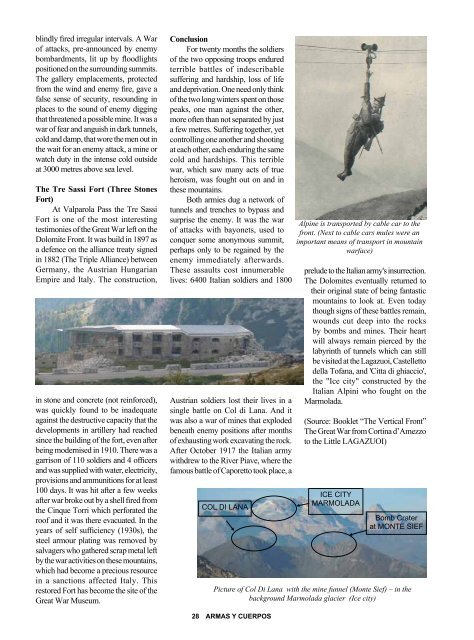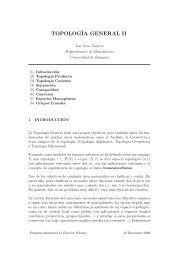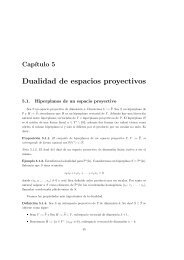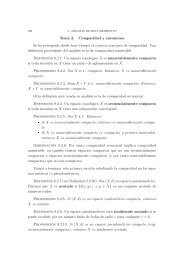Logística: Matemáticas y Ejército I. - Universidad de Zaragoza
Logística: Matemáticas y Ejército I. - Universidad de Zaragoza
Logística: Matemáticas y Ejército I. - Universidad de Zaragoza
Create successful ePaper yourself
Turn your PDF publications into a flip-book with our unique Google optimized e-Paper software.
lindly fired irregular intervals. A War<br />
of attacks, pre-announced by enemy<br />
bombardments, lit up by floodlights<br />
positioned on the surrounding summits.<br />
The gallery emplacements, protected<br />
from the wind and enemy fire, gave a<br />
false sense of security, resounding in<br />
places to the sound of enemy digging<br />
that threatened a possible mine. It was a<br />
war of fear and anguish in dark tunnels,<br />
cold and damp, that wore the men out in<br />
the wait for an enemy attack, a mine or<br />
watch duty in the intense cold outsi<strong>de</strong><br />
at 3000 metres above sea level.<br />
The Tre Sassi Fort (Three Stones<br />
Fort)<br />
At Valparola Pass the Tre Sassi<br />
Fort is one of the most interesting<br />
testimonies of the Great War left on the<br />
Dolomite Front. It was build in 1897 as<br />
a <strong>de</strong>fence on the alliance treaty signed<br />
in 1882 (The Triple Alliance) between<br />
Germany, the Austrian Hungarian<br />
Empire and Italy. The construction,<br />
in stone and concrete (not reinforced),<br />
was quickly found to be ina<strong>de</strong>quate<br />
against the <strong>de</strong>structive capacity that the<br />
<strong>de</strong>velopments in artillery had reached<br />
since the building of the fort, even after<br />
being mo<strong>de</strong>rnised in 1910. There was a<br />
garrison of 110 soldiers and 4 officers<br />
and was supplied with water, electricity,<br />
provisions and ammunitions for at least<br />
100 days. It was hit after a few weeks<br />
after war broke out by a shell fired from<br />
the Cinque Torri which perforated the<br />
roof and it was there evacuated. In the<br />
years of self sufficiency (1930s), the<br />
steel armour plating was removed by<br />
salvagers who gathered scrap metal left<br />
by the war activities on these mountains,<br />
which had become a precious resource<br />
in a sanctions affected Italy. This<br />
restored Fort has become the site of the<br />
Great War Museum.<br />
Conclusion<br />
For twenty months the soldiers<br />
of the two opposing troops endured<br />
terrible battles of in<strong>de</strong>scribable<br />
suffering and hardship, loss of life<br />
and <strong>de</strong>privation. One need only think<br />
of the two long winters spent on those<br />
peaks, one man against the other,<br />
more often than not separated by just<br />
a few metres. Suffering together, yet<br />
controlling one another and shooting<br />
at each other, each enduring the same<br />
cold and hardships. This terrible<br />
war, which saw many acts of true<br />
heroism, was fought out on and in<br />
these mountains.<br />
Both armies dug a network of<br />
tunnels and trenches to bypass and<br />
surprise the enemy. It was the war<br />
of attacks with bayonets, used to<br />
conquer some anonymous summit,<br />
perhaps only to be regained by the<br />
enemy immediately afterwards.<br />
These assaults cost innumerable<br />
lives: 6400 Italian soldiers and 1800<br />
Austrian soldiers lost their lives in a<br />
single battle on Col di Lana. And it<br />
was also a war of mines that explo<strong>de</strong>d<br />
beneath enemy positions after months<br />
of exhausting work excavating the rock.<br />
After October 1917 the Italian army<br />
withdrew to the River Piave, where the<br />
famous battle of Caporetto took place, a<br />
COL DI LANA<br />
28 ARMAS Y CUERPOS<br />
Alpine is transported by cable car to the<br />
front. (Next to cable cars mules were an<br />
important means of transport in mountain<br />
warface)<br />
prelu<strong>de</strong> to the Italian army's insurrection.<br />
The Dolomites eventually returned to<br />
their original state of being fantastic<br />
mountains to look at. Even today<br />
though signs of these battles remain,<br />
wounds cut <strong>de</strong>ep into the rocks<br />
by bombs and mines. Their heart<br />
will always remain pierced by the<br />
labyrinth of tunnels which can still<br />
be visited at the Lagazuoi, Castelletto<br />
<strong>de</strong>lla Tofana, and 'Citta di ghiaccio',<br />
the "Ice city" constructed by the<br />
Italian Alpini who fought on the<br />
Marmolada.<br />
(Source: Booklet “The Vertical Front”<br />
The Great War from Cortina d’Amezzo<br />
to the Little LAGAZUOI)<br />
ICE CITY<br />
MARMOLADA<br />
Bomb Crater<br />
at MONTE SIEF<br />
Picture of Col Di Lana with the mine funnel (Monte Sief) – in the<br />
background Marmolada glacier (Ice city)





